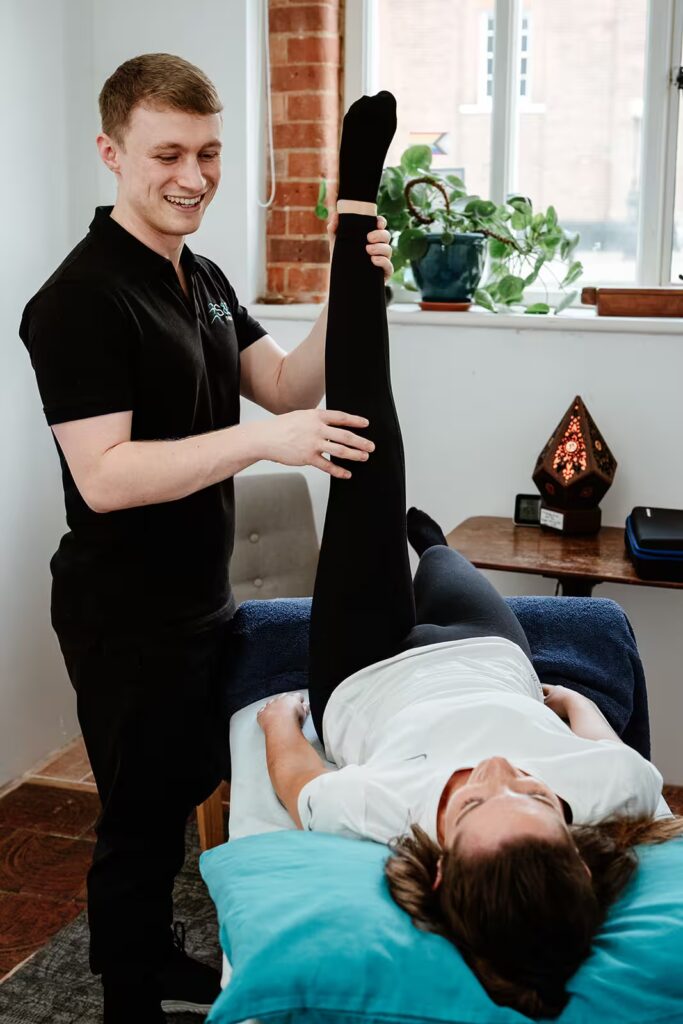
Knee Pain
Has your GP told you to manage your knee pain at home, but you’re still not seeing results? You’re not alone – we hear this all the time.
Ready to say goodbye to knee pain?
Knee pain is a common issue that can affect people of all ages. Whether it’s a dull ache or sharp pain, it can make simple everyday activities like walking, climbing stairs, or exercising feel difficult or even impossible.
The knee is a complex joint. It supports your body’s weight and allows you to move – making it especially vulnerable to injury, overuse, and wear and tear over time.
Knee pain can range from mild discomfort to debilitating pain, and understanding the cause is key to finding the right treatment.
Common Causes of Knee Pain
Knee pain can arise from a variety of factors. Here’s a breakdown of the most common causes:
- Injuries
- Sprains/Strains: Damage to ligaments or tendons, usually from contact injuries, falling or pivoting.
- Meniscus Tears: Cartilage damage, often from twisting.
- ACL Injuries: Common in sports during twisting or pivoting movements and contact injuries.
- Patellar Dislocation: Kneecap shifting to the side of the knee.
- Arthritis
- Osteoarthritis: Wear and tear of the knee joint.
- Rheumatoid Arthritis: Inflammation from an autoimmune condition.
- Overuse and Repetitive Strain
- Patellofemoral Pain Syndrome: Pain around the kneecap, often with activity.
- Tendonitis: Inflammation of the knee tendons.
- Bursitis: Inflammation of the knee’s cushioning sacs.
- Poor Biomechanics
- Poor movement control from the foot or hip can impact knee positioning, leading to increased strain on certain areas, as well as increased injury risk.
Why early treatment matters
Ignoring knee pain can lead to increased pain and reduced functional ability – which can make normal day-to-day activities painful. Symptoms like swelling, stiffness, locking in one place, or a feeling that your knee is “giving way” are signs that your knee needs attention.
Getting the right treatment early can speed up your recovery, prevent further damage, and help you stay active and independent long term.
We can help
Your Physiotherapy journey will begin with a thorough consultation. We take time to understand your knee pain, how it’s affecting your life, and your personal goals.
From there, we create a personalised treatment plan designed to:
- Relieve pain
- Restore movement
- Improve strength and stability
- Support long-term recovery and injury prevention
What treatment will we use?
- Manual therapy – To relieve muscle tension, improve joint mobility, and reduce pain
- Targeted home exercise plan – Tailored exercises to strengthen muscles around the knee and improve movement mechanics
- Functional movement training – To improve performance in everyday activities
- Biomechanical assessment – To identify and correct movement imbalances
- Hot or cold therapy – To relieve inflammation and/or pain
- Acupuncture or dry needling – To help reduce muscle tension and joint pain
Ongoing Support for Lasting Results
Here at S&C Therapy, we can help to reduce knee pain, improve function and strength, enhance flexibility, and prevent future problems. Follow-up sessions help us to track your progress, make adjustments to your plan, and ensure you continue moving in the right direction.
